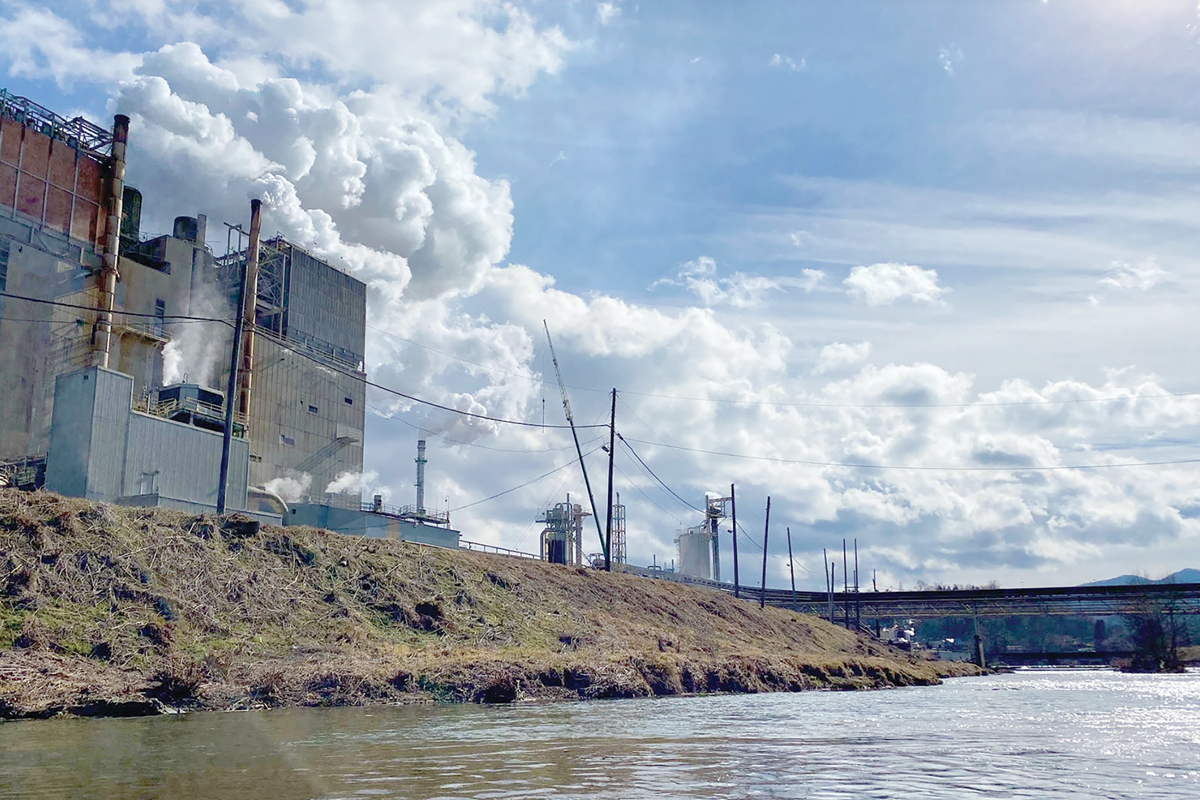Bringing in the feds: EPA agreement mandates elements of Canton mill cleanup
 Surface water spills on the Pigeon River near Canton’s shuttered paper mill have been the EPA’s focus. File photo
Surface water spills on the Pigeon River near Canton’s shuttered paper mill have been the EPA’s focus. File photo
Pactiv Evergreen, owner of the shuttered papermill in Canton, has been working to clean up two separate seeps leaking toxic substances into the Pigeon River under an administrative order of consent (AOC) with the Environmental Protection Agency.
While the North Carolina Department of Environmental Quality (NCDEQ) has been working with Pactiv to address both seeps, the EPA became involved, in a sense, by happenstance. The AOC notes that the EPA’s Atlanta office was informed by a “citizen” that there were ongoing releases of fuel oil from the site. Ken Rhame, an EPA site coordinator, was in Cruso looking into a relatively small oil sheen on Rattlesnake Branch. Another man noticed his government plates and asked Rhame if he was someone from FEMA working on the recovery from 2021’s catastrophic flood that ravaged the area. Rhame explained his purpose.
“He made the comment, ‘if you think the fuel oil spill is bad, you should see the one at the paper mill,’” Rhame said.
Rhame verified the fuel oil seep with NCDEQ and Pactiv and things began to move. In September of last year, the AOC was finalized.
In light of those cleanups, EPA has designated part of the property a Superfund site. The Comprehensive Environmental Response, Compensation and Liability Act (CERCLA), also known as Superfund, allows the EPA to both clean up a contaminated sites and also force the responsible parties to either perform a cleanup or reimburse the government for its cleanup of a site. But while it is technically a Superfund site, it may not be quite what people think of when they hear the term. The largest cleanups, which can be sitewide and take decades, are on the “national priority list,” but that’s not the case for the mill; it is considered a critical removal action, which tend to take only a year or so to finish.
The AOC addresses the seeps of No. 6 fuel oil and black liquor impacting the Pigeon River. Relevant water samples reviewed by the EPA led to the determination that releases of No. 6 fuel oil and black liquor pose a threat to public health and the environment.
Related Items

In a photo taken in February 2022, black liquor deposits sit in the Pigeon River. AECOM photo
The black liquor seep has been a long-known issue that was first reported to NCDEQ in in 1994.
Black liquor is a byproduct from the production of paper. The Canton mill produced paper from both hardwood and softwood using the kraft process. The kraft process is used to convert wood into wood pulp. This involves treatment of wood chips using water, sodium hydroxide and sodium sulfide. This mixture is known as white liquor. The white liquor separates the lignin from the wood fiber, or pulp, from which paper is made. Black liquor is the spent liquor or the byproduct from this process. According to the AOC, prior to the shutdown, the mill hardwood fiberline produced up to 820 tons of paper per day, the softwood fiberline produced up to 640 tons of paper per day, which created a substantial amount of black liquor.
“When Champion sold the Mill in 1999, Champion retained certain obligations and liabilities associated with the black liquor seep,” the AOC reads. “While attempts to recover black liquor in the groundwater were eventually abandoned, International Paper, which purchased Champion in 2000, has been conducting semiannual monitoring at the Mill’s existing well network since 2007.”
The other seep addressed in the AOC involves No. 6 fuel oil, which was stored onsite and used to heat boilers and kilns as part of the paper-making process and as an energy source for mill operations. The fuel oil was kept in two massive above-ground tanks and was used until the mill shut down. Like with the black liquor, Pactiv and NCDEQ had already been working on a potential removal plan for the fuel oil prior to EPA’s involvement.
On Jan. 28, 2022, Pactiv notified NCDEQ of a brownish material on the east side of the Pigeon River that remained visible in the streambed for about two weeks. The material was identified as black liquor. Since then, that seep has been a regular cause for NOVs. An email from Pactiv to NCDEQ specifies the severity of the seep.
“Although we do not have a firm estimate of the amount of oil collected and disposed of using this process, PTVE [Pactiv] estimates that the oil/water mixture sent off‐site for disposal contains 10-15% oil and that, on average, 2.5-4 gallons of oil are being collected per day,” that email reads. “Overall, PTVE estimates that around 250-375 gallons of oil has been collected and sent off site for disposal in 2023 (year to date).”
The first step in the fuel oil cleanup was to pump the remaining oil the tanks and complete an inspection. That inspection confirmed that the oil was leaking into the ground out of holes that had formed in the bottom over the years.
Next, regulators and workers had to figure out how the fuel oil was getting from the soil under the tank into the river. Looking at old schematics from when the mill was constructed, they noticed an abandoned municipal sewer line that ran parallel to the flood control levee before cutting toward the river. Upon investigation, they saw that the old terracotta pipes had been damaged in several places, allowing the fuel oil to enter the sewage line. Next, they used borescopes to inspect the sewer line and discovered that it eventually ran into a manhole from which oily water was recovered and pumped to the sewer plant.
A huge portion of the work on the fuel oil cleanup involved excavation, which one email says amounted to around 10,000 tons of soil from underneath the tanks being hauled off. Once they got to about a foot below the groundwater, even though there was still some indication that there was some contaminated soil left, they had to leave it alone because of the groundwater table. It was agreed upon that the excavated soil, as long as Pactiv could demonstrate that it was non-hazardous, could be brought to the White Oak landfill in western Haywood County.
At this point, the fuel oil cleanup is mostly complete, while the black liquor seep still needs time.
Every element of the project must be coordinated and reported to the EPA, including costs and information on contractors and subcontractors that may be involved in the monitoring or cleanup. On the EPA’s end, that means the on-scene coordinator, which ended up being Rhame, the man who was first told by the citizen about the sheen on the Pigeon River from the fuel oil. Rhame has broad authority, including oversight of Pactiv’s implementation of the work, authority to halt, conduct or direct any work or to direct any other removal action undertaken at the site.
According to the AOC, around the beginning of this year, Pactiv was required to submit a work plan to the EPA that outlined how it would reduce impacts to residential areas, schools, playgrounds, healthcare facilities or recreational public areas during the removal. In addition, it was required to say how it would conduct monitoring in those “community areas of impacts from the implementation of the removal action.” Pactiv is also required to submit quarterly progress reports that describe “all significant developments during the preceding reporting period,” including analytical data obtained and any changes to schedule.
One section of the AOC notes that the EPA has the lead responsibility for implementing “community involvement activities” including a community involvement plan. This could include public meetings. While there haven’t been any such meetings yet, any member of the public could request one.
If the EPA determines that Pactiv has ceased implementation of the work or is otherwise deficient, it can take over the work for up to 60 days. To ensure completion of the work, Pactiv Evergreen had to take out an insurance policy for $1.5 million, something the EPA called “satisfactory.” There are also potential noncompliance penalties outlined in the AOC, ranging from $250 per day to $750 per day, depending on how long the problem persists. There is also a work takeover penalty of $50,000.
There has been a lot of talk about who, if anyone, might purchase the mill property. The AOC addresses a potential sale, as well, noting that transferring the property doesn’t absolve Pactiv of its responsibility.
“… prior to entering into a contract to Transfer any of its property that is part of the Site, or 60 days prior to a Transfer of such property, whichever is earlier, (a) give written notice to the proposed transferee that the property is subject to this Settlement; and (b) give written notice to EPA of the proposed Transfer, including the name and address of the transferee.”
The AOC stipulates that Pactiv must provide — under penalty of perjury — a final report within 60 days of completion of the work. That report will summarize actions taken and provide specific details, including a list of quantities and types of materials removed from offsite or handled onsite.
This isn’t Pactiv’s only recent brush with the EPA. In October of last year, the regulatory body announced that it had finalized a $2.1 million consent agreement and final order with Evergreen Packaging for alleged Clean Air Act violations tied to the company’s Pine Bluff, Arkansas location.
“CAFO alleges that Evergreen failed to control hazardous air pollutants (HAPs) at their facility, did not meet fuel specifications for boilers, and failed to close washer windows/hoods during operation. Evergreen Packaging LLC must pay a civil penalty of $256,973,” a release read.

This map depicts where all the sampling wells are at the paper mill site. Pactiv Evergreen map
And the current cleanups at the paper mill site may not be the only involvement the EPA will have there. While it isn’t involved in any other efforts, there are still ongoing monitoring efforts that could lead to more discoveries worthy of EPA intervention.
In a Smoky Mountain News story from earlier this year, Clean Water for North Carolina Executive Director Hope Taylor said that given how long the mill was operational, there could easily be more cleanup needed.
“I suspect that there is a long legacy of pretty toxic chemicals just because the bleaching and heat processes involving chlorine would necessarily have produced a lot of chlorinated hydrocarbons, including dioxin,” she said.
In recent months, Pactiv Evergreen has received notices of violation for several items, including discharge toxicity and high fecal coliform concentrations. Fecal coliform is a group of bacteria that includes disease-causing species such as E.coli. While most coliform bacteria do not cause disease, some strains of E.coli cause serious illness. According to the U.S. Environmental Protection Agency, swimming, diving or wading in water contaminated with fecal bacteria can result in diarrhea, vomiting, respiratory illness and other health problems. Skin, ear, eye, sinus and wound infections can also be caused by contact with contaminated water. Back in February when the fecal coliform NOV was issued, an N.C. Department of Water Resources spokesperson said the department “has been in communication” with mill owner Pactiv Evergreen to address these violations, and that the mill has informed DWR that it installed new chlorination equipment at the head of its wastewater treatment plant to prevent future contamination.
For the EPA to get involved in another cleanup, NCDEQ would have to submit a removal site evaluation. In addition, there’s no guarantee another entity may not file a lawsuit, depending on how the cleanup plays out and what other environmental issues may be discovered.
Either way, even though the removal of the No. 6 fuel oil and black liquor seeps may be completed relatively quickly, it’s still likely that the overall cleanup effort — whether the EPA is involved or not — may still take decades, even if the property is transferred and repurposed.
While sources who spoke with SMN didn’t want to be quoted as they explained the removal process, most noted that since the EPA became involved, Pactiv has done a good job of holding up its end of the bargain. Rhame went ahead and said it on the record.
“Pactiv has been easy to work with and cooperative,” he said.
Before long, the public should be able to gain more extensive insights into the mill’s overall environmental impact. Last September, EnSafe, the contractor Pactiv is partnering with to collect water samples to analyze for chemicals and contaminants, conducted its first major quarterly analysis, and another was completed in January. Additionally, a research project from the N.C. Collaboratory headquartered at University of North Carolina Chapel Hill, announced in October that it will investigate contamination levels outside of the mill’s property line.
Folks at the state level are watching the situation closely. NCDEQ Secretary Elisabeth Biser has made some strong statements about her intention to ensure Pactiv Evergreen lives up to its responsibilities.
“The DEQ’s role in this is to hold the responsible party accountable, to make sure that the right steps are taken, prevent further impacts to the town and residents and also first and foremost to make sure that the site is remediated for future productive use,” she said during a May 2 roundtable discussion with local leaders. “We will hold the company accountable for responsible closure.”
Canton Mayor Zeb Smathers said he’s waiting with interest to see how the rest of this plays out.
“I expected that both DEQ and EPA would do exactly what they said they would, that they continue to hold Evergreen to the law and their environmental obligations, and I am appreciative for that,” Smathers said. “As we go forward to the next steps, the responsibility of Evergreen and whoever occupies that site will be to our town, our county and our environment. We know in time that Evergreen will not be here, but our people and the generations after us will be, and we need to give them a Haywood County that is better than we found it.”













